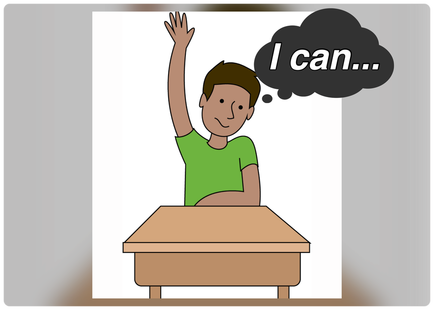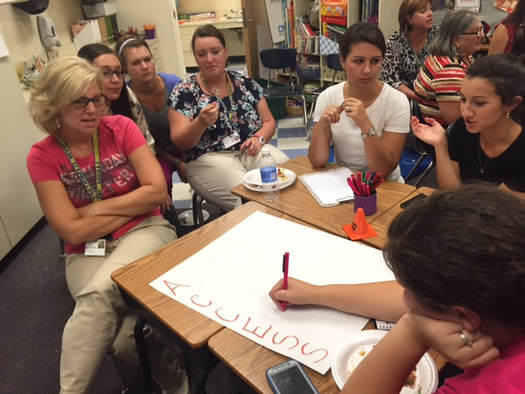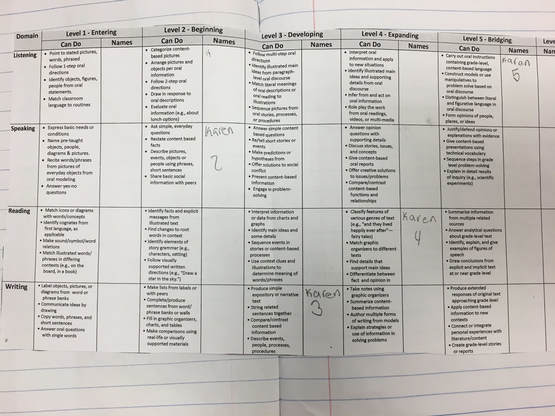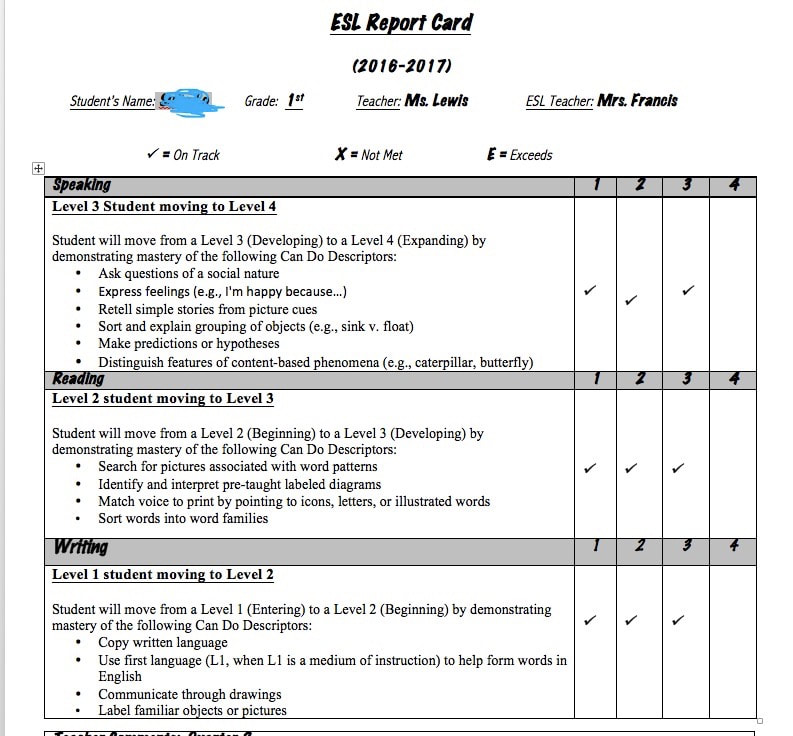|
Tan Huynh invited me to guest post on his website about my methods on grading English language learners and newcomer students. **This post appeared originally in www.empoweringELLs.com on August 7, 2017.** As an English as Second Language (ESL) teacher, my job is to analyze my students’ needs and develop their linguistic and communicative competence in English-speaking, reading, listening, and writing skills. My goal is to help them achieve a proficient level of English that allows them to function independently in their classrooms, and in society in the future. To help me accomplish my goal and perform my job as an ESL teacher I have the WIDA (World-Class Instructional Design and Assessment). North Carolina is part of the WIDA consortium of states dedicated to the design and implementation of standards and equitable educational opportunities for English Learners (ELs). As an ESL teacher, I use WIDA standards along with Common Core State Standards to
Undoubtedly, one immeasurable reward I find in being an ESL teacher is seeing my students reach a high proficiency level of English and to be able to function independently in core instruction. So, merging my personal experiences as an EL with my obligations as an educator, I see the critical need and responsibility to serve as an advocate for my students. Thus, I use the WIDA Can Do Descriptors! The Can DO Descriptors provide a clear and basic overview of ELs’ ability based on their initial or annual language proficiency test. This powerful document highlights what our ELs CAN do at various stages of the language development and for each language domain as they interact with core content. I encourage you to take advantage of these valuable documents that by the way are free through the WIDA website. Even if your state is not a WIDA state, these documents can be a great tool not only for you as an ESL teacher, but also for mainstream classroom teachers, students, and parents! TIP #1: Share the CAN Do Descriptors with Mainstream Classroom Teachers.At the beginning of the each school year, I gather all the teachers at my school and we go over ACCESS, CAN DOs, accommodations, and modifications. For teacher buy in, I make sure my presentation is fun and engaging. I begin by giving them the acronym ‘ACCESS’ (Assessing Comprehension and Communication in English State-to-State) and they have to guess as a group what each letter stands for. The group who gets most letters correct gets a small price! Teachers learn how to read their students’ language proficiency levels and use the CAN Do name charts to chart each student in his/her corresponding proficiency level for each language domain. These are the name charts we use: Kindergarten, First grade, Second-Third, Fourth-Fifth. Higher grades are also available on the WIDA website. Teachers understand that even though students receive a proficiency composite score, it’s imperative to see which domain is the student’s strength and/or weakness to better support during instruction. Teachers also receive this document that provides linguistic accommodations teachers can use to support students access core without having to water down content. This other document is also helpful since it provides Bloom’s Taxonomy questions differentiated by language proficiency level. TIP #2: Share the CAN DO Descriptors with your StudentsThis year I started sharing with my students not only their ACCESS scores but also the CAN DO Descriptors. I never thought how exciting this would be for all my students. They all loved looking at their scores and charting their name on the appropriate proficiency level for each language domain. You could hear students say: “Look, I am really high in speaking!” or “Look, I really need to work on my writing.” Students received two highlighters, one to highlight the current CAN DO statements, and another one to highlight the goal we set for next school year. Their CAN DO chart is glued in their daily notebook so when we used them they can see it and be encouraged. Next school year, I will be using this student friendly CAN DO charts. Not only are they colorful, but they’re much better for them to read and understand. I believe without a doubt that students need to be explicitly taught the expectation we have of them from the very beginning. My students understand that their teacher, their parents, and I know exactly what they can and cannot do.They have a clear understanding and a visual of where they are linguistically and where my goal is for them to be by the end of the school year. They know that I will be reporting quarterly to teachers and parents how they are progressing toward their language proficiency goals. TIP #3: Share the CAN DO Descriptors with Parents: Yes, you read this right...share it with your student’s parents! The CAN DO Descriptors are such a powerful tool for teachers and students that this year I decided to start sharing it with parents through a progress report format. Let me elaborate; When I get my students’ ACCESS scores, I analyze each and every student’s data to determine their school year language goal. It’s really all about getting to know your students to better support them in the language domains they need it most. For example: If Emily’s ACCESS report states that she made a 3 in speaking, then her goal for the year would be to master the 3 and make it to a 4. If she made a 2 in reading, her goal for the year would be a 3...so on and so forth. If a student makes a 5 or 6, then there is no goal assigned for that domain since the student had shown mastery on the domain. A student could have 1 - 4 goals depending on his/her language proficiency. In order to have parent support in helping their child grow linguistically and academically, I provide them with a quarterly progress report that lets them know how they are doing throughout the year. Teachers may also get this report if they wish to see how their student is doing in ESL. I make the effort to honor my students’ family language by translating their progress reports. WIDA has the descriptors available in Spanish if you wish to use them! I know for a fact that our parents would appreciate receiving such valuable document in their native language. Take a look at this example! Our county is fortunate to use ELLevation, an online platform that houses our ELs’ data information and provides language strategies. It is through this platform that we can assign students’ language goals and note their progress. The ELLevation goal bank offers goals for newcomers as well! This allows me to provide a report for students who are just entering the language proficiency levels spectrum. It also gives me an idea of what I should be focusing on students who are new to the English language. These are the progress reports I use. Feel free to download, edit, and use as you like. I won’t lie to you...it takes some work to put them together but in the end, it is all worth it because you’re providing accurate and helpful information to your students, teachers, and parents. As you can see, there is so much we can get out of such a valuable document such as the Can Do Descriptors! Now you know that not only is a tool that we can use as ESL teachers to support the students we serve, but it CAN be so much more! Our students CAN DO...Let’s show that they can! If you are on Twitter, join us by posting ELLs’ success stories using #ELs_CAN so we can celebrate with you! **Updated 08/20/17 Added middle school grades and high school ESL progress reports Thank you for reading!
21 Comments
Rita Perez
10/11/2017 09:12:37 am
This is an amazing article. Is there a place that I can down load the WIDA Can Do charts for students?
Reply
Emily Francis
10/12/2017 10:39:47 am
Hi Rita,
Reply
Elaine Cusick
2/15/2018 07:08:51 pm
I am an ELL teacher just outside of Boston. I stumbled upon your site as I was searching for more useful , positive tools to monitor the progress of our KG and Gr 1 ELLs. We already have the WIDA Can Do descriptors in use but have much further to go to truly embed them in our practice across the school. Our progress monitoring at this time consists of too many instances where we point out that a child is not meeting a benchmark rather than acknowledging the tremendous progress they have made in ELD. I have downloaded your examples and will be sharing them with my colleagues, with credit to your blog site. Thanks for the work you have done - love your blog it is inspiring me to work harder in my corner of the ELL world, too. Thank you.
Reply
Michelle Batista
5/13/2018 09:49:45 pm
Thank You so much. I am looking for ideas on ways to get mainstream teachers on board. This was very helpful.
Reply
Emily Francis
5/14/2018 08:22:19 am
Michelle, I am so happy to hear how this post is going to help you reach out mainstream classroom teachers!! If there is anything else I can do to support you, please let me know.
Reply
Julie
5/21/2018 05:46:29 pm
I stumbled across your site looking for information on how to grade ELLs in English language arts. This post was very helpful in other ways. Thank you for sharing your examples and such useful information. I'm still looking for an answer to my question, though.
Reply
Emily Francis
6/7/2018 12:10:22 pm
Hello, Julie,
Reply
Aura
8/16/2018 04:34:10 pm
Awesome!! I will share it with my classroom teachers and especially the parents! Thank you so much for the idea!
Reply
Emily Francis
8/18/2018 11:00:47 pm
That's fantastic, Aura! Please keep me posted and let me know if you have any questions!
Reply
Ghada Amad
9/25/2018 02:41:57 pm
Hello,
Reply
Emily
9/30/2018 04:51:46 pm
I appreciate your comment! I am glad you found this post helpful! Keep me posted if you do share with your teachers!!
Reply
Shannon Hammond
10/29/2018 11:22:10 am
Thank you so much for sharing! Great resources!
Reply
Emily Francis
10/30/2018 01:53:58 pm
You welcome! I am glad you found these resources helpful!
Reply
Trish
6/22/2019 10:41:18 am
Thank you!!! As a new ELL coach I was looking for something to give to teachers and help them have something to analyze and use frequently!!! This is simply awesome!!!
Reply
KathyJ
9/23/2019 11:59:11 am
I've taught ELD/ESL for years and have never thought to use the Can Do Descriptors - I mean really use them! I always share with the classroom teachers of my ELs, but never use the Descriptors with students, although I show them their WIDA scores. I thoroughly enjoyed your post - thank you for the ideas!
Reply
MegD
11/1/2019 10:23:28 am
This is a great resource! In one of your examples, you have the Can Dos translated into Hmong--where did you get those? Is there any way our school could get a copy? Thanks for this post!
Reply
Amanda Welcome
1/20/2020 07:40:58 pm
Thank you! This is amazing work you have done!
Reply
MelanieJ
8/11/2020 10:36:58 am
The information about the name charts and how you can use them with the students is great! I appreciate all the resources! I do have a question though - If the ACCESS results come out in the spring, how can we use them for the next school year, do we put the student's name on the chart for the grade level for the previous year or the current grade they are in for the fall?
Reply
Gicela
10/26/2021 02:04:01 pm
Hello!
Reply
Emily Francis
11/11/2021 08:25:37 am
I am so glad to hear you found this information helpful. Thank you for taking your time to leave a comment!
Reply
1/22/2024 05:35:22 am
Great tips! Encouraging students to explore their local library not only enhances their academic resources but also fosters a lifelong love for learning and community engagement.
Reply
Your comment will be posted after it is approved.
Leave a Reply. |
Categories
All
Archives
May 2024
|




